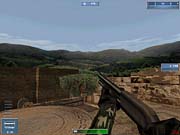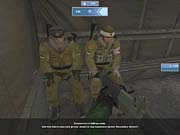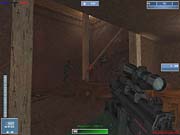Global Operations Updated Preview
We get some play time with this first-person shooter that's being developed by the makers of Counter-Strike beta five.
The amount of people who still play Counter-Strike to this day, two and a half years after its first release, is a testament to the game's staying power. There's no doubt about it--the game is fun and addictive, and the gameplay never gets old. But to be fair, there's another reason for Counter-Strike's popularity: It's the only one of its kind out there. Sure, there are similar shooters available like Wolfenstein and Ghost Recon, but their focus is entirely different from Counter-Strike's, and anyone who wants a fast-paced team-based shooter with modern-day settings and weapons doesn't have a whole lot of options right now. That'll all change early next year with the release of Global Operations, a first-person shooter that pits terrorist against counterterrorist in one of 13 modern-day scenarios. Sound familiar? The similarities between Global Operations and Counter-Strike aren't an accident, as this game is being developed by Barking Dog, the same team who worked on beta five of the popular Half-Life mod. Having said all that, however, the two games have some core differences, not the least of which is Global Operations' class-based system. We'd heard the designers of the game talk about its different classes before, but during a recent multiplayer session at Electronic Arts, we were able to experience this unique aspect of Global Operations for ourselves. (For details on Global Operation's core gameplay, be sure to read our original preview.)

This system works in pretty much the same way that Wolfenstein's multiplayer component does: pick a map, pick a team, pick a class, pick a weapon, pick a fight. Like in Counter-Strike, the levels are split up into different gameplay modes, including bomb defusion, hostage rescue, assassination, escort, and so on. The maps are all set in current global hotspots like Mexico, Chechnya, and Sri Lanka, and each of these 13 levels has a unique terrorist and antiterrorist group that you can play as--some quick arithmetic will reveal the total number of teams to be 26, significantly more than Counter-Strike's eight. What's more, these 26 teams are all specific to their level's location, so if you choose to play in Chechnya, you'll get to choose to fight as either the Russian Army or the Caspian Freedom Force. The actual breakdown of the classes, however, is the same across all 26 teams. Specifically, each side has six player classes that you can choose to play as: medic, heavy gunner, demolitions expert, sniper, commando, and recon. These six are the developer's means of ensuring that players play as a team, because while one skilled person can technically keep his or her team winning in Counter-Strike, one sniper or one commando in Global Operations can't.

These different specialties aren't determined by what weapons the six classes can or can't carry, but by genuinely unique attributes that affect how they behave on the battlefield. Barking Dog compares the class system in Global Operations to choosing different races in role-playing games. For instance, while certain classes aren't capable of buying certain weapons on the menu screen, anyone can pick up any weapon that's been dropped on the field of battle. But that doesn't mean that they'll be able to use it as proficiently as that weapon's previous owner, though. For instance, a medic isn't allowed to purchase anything more powerful than a submachine gun from the buy menu, but if he happens across a dropped sniper rifle in the game, he will be able to pick it up and even use it halfway decently. A sniper, however, will be able to use a sniper rifle with a greater degree of ease, as he can reload faster, aim with a steadier hand, and move faster with that weapon than any other class can. Let's take a more detailed look at the six classes.
Prior to jumping into a match, you'll be presented with the opportunity to choose one of six classes. They can all carry a handgun, but the following six classes vary greatly from each other in every other respect.
Medic: Obviously, the medic's primary role is to heal injured teammates, which he does using his medpac. Like the medic in Return to Castle Wolfenstein, he can also revive fatally wounded comrades for a percentage of their original health before they respawn. The medic also has the unique ability of being able to discern his teammates' status by simply glancing at his radar: green indicates a healthy teammate, yellow means injured, and red denotes a critically wounded player. He can't buy any secondary weapons, and his primary weapon slot is reserved for submachine guns only, but this lack of heavy weaponry can be made up by his speed.
Heavy gunner: The heavy gunner is the slowest of the six classes, though he's also the most powerful. He can equip his primary slot with a machine gun, the most powerful form of rifle in the game, and his secondary slot can be outfitted with a shotgun for an even bigger punch. He's also only one of the two classes that can equip themselves with heavy armor in the buy menu. His lack of speed balances out his formidable arsenal and defensive capabilities, though.

Demolitions expert: This player class is the only one that can detect bombs on his radar screen, and he's the fastest at defusing those bombs. He can buy a variety of grenades at once from the buy menu, and he can throw them much farther than anyone else can. The demolitions expert's primary weapon is a grenade launcher, though like all the other classes, he can pick up any weapon he finds on the field.
Sniper: The sniper is one of the fastest classes in the game, though he is also one of the least protected. He has sniper bonuses that include being able to reload rifles faster and having a steadier aim than anyone else on his team. His negative characteristics include being limited to light armor and not being able to buy any secondary weapons.

Commando: The commando is the most well-rounded player class in Global Operations, as he's not the fastest, or the most powerful, or the best shot, but rather a happy medium of all the major attributes of the five other classes. The commando's running speed varies with the type of armor he's wearing, and he can equip an assault rifle as his primary weapon and a submachine gun or shotgun in his secondary slot. Additionally, he's automatically given a portable rocket launcher as a third weapon.
Recon: Offensively, the recon is the weakest of all the classes in Global Operations, but he's aided by several unique advantages, including a wider field of vision than his teammates. His binoculars also let him spot enemies at greater distances than others can, and his thermal goggles make it easier to detect other soldiers in low-light situations. The recon is also the fastest of all the classes in the game.

If six classes aren't enough to distinguish Global Operations from Counter-Strike, then the seventh will. As the game's seventh class, the intelligence officer, you won't actually go into the field of battle. Instead, you'll be presented with a unique interface that lets you oversee all of your team's actions. This interface is split up into two screens that you can switch back and forth between. The first is an overhead tactical map of the level your team is currently playing. From here, you can see all of your team members' locations in real time, place waypoints in different areas in order to tell them where to go, and use a chat field to coordinate a timed attack. As soon as you drop them down, the waypoints instantly appear on your teammates' radar. Your second interface will be a series of camera windows, each of which streams a live feed from numerous areas around a map, including static security cameras and shoulder-mounted cameras on all of your teammates. The setup is laid out in an interesting manner. There's a large camera window in the middle of the intel officer's interface, and three smaller ones at the bottom. These small windows all display the feed at 5fps, whereas the full-size window runs at 30fps. You can arrange these windows any way you like, so you'll be able to keep the action centered in the main window, while still keeping an eye on developing events via the smaller ones.
Before you're able to monitor the battlefield using the intel officer's interface, however, your teammates actually have to capture a terminal that controls that level's cameras. Either side can take control of this terminal, thus giving their respective intelligence officers the ability to use their camera interface. But there are other ways to disrupt the opposing team's intelligence capacity by shooting out cameras, although destroyed cameras will respawn after 30 seconds.

Other notable differences between Counter-Strike and this game include the manner in which bombs are defused. For anyone other than the demolitions expert, it'll take roughly 15 seconds to defuse a bomb, but unlike in Counter-Strike, defusing a bomb in Global Operations involves more than just holding down the action key. Here's how it works: The bomb has three wires--a red one, a blue one, and a yellow one--one of which is randomly selected to deactivate the explosive device when cut. The other two go boom. Every five seconds or so, one of the wrong wires is eliminated, until you're only left with the correct wire to cut. Of course, if you're late in finding the bomb, you can always guess and snip one of the three wires without waiting for the elimination indicators.
Global Operations is filled with similar types of subtle but significant nuances, like a system that tracks bullet penetration through different material types, weapons that can be completely customized with scopes, silencers, and larger clips, gas grenades that impair players' vision, and invincible sniper bots that chase away spawn campers. All these enhancements to the tried-and-true gameplay of Counter-Strike, coupled with impressive graphics provided by a heavily upgraded LithTech 2.0 3D engine, should make for a welcome change for shooter fans. Global Operations is scheduled for release in the first months of 2002, and we'll keep you updated as more news develops.
Got a news tip or want to contact us directly? Email news@gamespot.com
Join the conversation